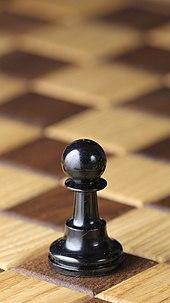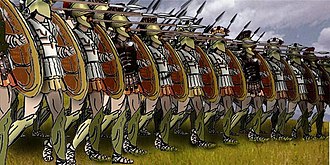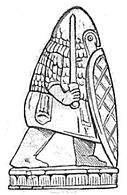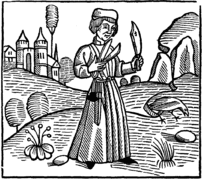Pawn (chess)
The pawn is a chess piece. At the start of a game, each player has eight pawns that are arranged on ranks 2 and 7, ahead of the rest of the pieces. The pawn moves vertically along the file it is on, without being able to go back. In the first movement, from the starting point, two squares can advance and, from there, one by one.
In order for a pawn to capture the piece it must move from its starting place immediately in the diagonal file. The opposing pawn that advances two squares in its first move on the adjacent file and that stands on the same file as the pawn that is going to make the capture. Upon reaching the last rank it becomes any other piece, excluding the king, a move called coronation or promotion; the pawn will be immediately replaced by another piece that can be a knight, bishop, rook or queen and must be removed from the board. The promotion is not limited to previously captured pieces, but rather the player can choose the piece to which he wants to promote, so it is possible for example to have more than one queen on the board. The pawn is present even in variations of the game, having served as an inspiration for some non-orthodox pieces.
Originally, they were the military representation of the infantry, but, in the Middle Ages, it was interpreted in morality as peasants and the possibility of promotion, a metaphor for the possibility of social mobility through a virtuous path (straight). The chess pieces are taken as a unit of value. They become more valuable as the chance of promotion increases, which can influence the strategy adopted by players.
Origin and etymology
According to the legend of Sisa, the Brahmin Sisa created the chaturanga, the oldest forerunner of chess, at the request of the Indian Rajah Balhait. Sissa was based on the figures of the Indian Army, and included the piece today known as the Pawn as a representative form of the infantry and the role it played in the armies during war.
According to Greek accounts, this was the composition of the Indian army from the 4th century century BCE. The word chaturanga, which later named the first version of the game, has a meaning attached to the parts of the army in the Ramayana and the Mahābhārata, in which the army it is expressly named hasty-ashwa-ratha-padatam of which padatam is the Sanskrit word for a soldier.
In Persian the piece was called Piyada and in Arabic Baidaq, both with the same meaning as in Sanskrit. In most European countries, the piece has the name related to the infantry, which was originally represented, being peão in Portuguese, pedina in Italian, bauer in German and pawn in English.
Archaeology
The oldest artifacts found are from the Afrasiab set of pieces, found in Uzbekistan in the 1970s. The pawns are small figures of the kneeling soldiers, down on one knee, holding sword and shield as if at the ready for combat.
Muslims developed simpler, more stylized designs following Islam's prohibition against depicting living figures. The pawns are the smallest pieces, following the importance of the military ranks, and with a dome format. In the Ager set of pieces, the pawn is a small cylindrical block.
The Lewis Pieces artifacts contain 19 stylized pawns with various shapes and sizes resembling tombstones or obelisks. Most have a hexagonal base and two pieces are decorated or engraved.:small-caps;text-transform:lowercase">XI which broke the myth that the set actually belonged to the Carolingian Emperor, who lived in the VIII.
Since the 15th century, chess spread throughout Europe and Russia. The pawns continued to be represented in a stylized way, with a format similar to each other, similar to those of the Staunton pieces. There were some exceptions such as sets made in Augsburg that represented the pawns according to the trades indicated in the morality 'Liber de Moribus Hominum et Officiis Nobilium Sive Super Ludo Scacchorum' written by Jacobo de Cessolis in the 13th century. The trades are, starting with column a: farmer, blacksmith, tailor, merchant, doctor, innkeeper, guard and messenger.
Image gallery
Movement and relative value
In the initial position of the pieces on the board, each player has at his disposal eight pawns, positioned on the second rank for White, and on the seventh rank for Black. Its move consists of advancing to the vacated square immediately in front of the same file or, on the first move optionally, by two squares on the same file, as long as both squares are unoccupied. This advance was introduced to Europe during the Middle Ages, but was only standardized with the establishment of rules in the late 15th century. In Spain and Germany, this advance is only allowed if there was no capture of pieces and in Germany it was still restricted to the pawns of the rooks, queen and king.
Capture by taking the place occupied by the opponent's piece that is diagonally in the row immediately in front of it, taking the place of the piece. If a pawn attacks the square through which a pawn passes the opponent has advanced two squares on its first move, the attacking pawn can capture the opponent, thereby occupying the square the opponent's pawn passed over. This characteristic capture is called en passant capture and is only allowed on the move following the advance of the opposing pawn.
The movement to the step was introduced around the centuryXV and was described by Lucena in Repetition of Chess Loves and Art (1497), but it was only uniformed around the centuryXVIIIWhen the Italians left the passar bataglia. According to the FIDE, it is not necessary to assign a specific letter for the pawn in algebraic chess notation, which will be used in the official tournaments. In newspapers and literature, the use of figures or diagrams is recommended (![]() and
and ![]() )
)
Usually, the relative value of the Pawn is arbitrarily attributed as a point even though the central pawns are more valuable. However, in endgames the value may be higher as they progress and there is a possibility of being promoted. The value of the pawn may vary depending on the existing pawn pawn structure. Doubled pawns are worth 0.75 points if they can undo such a weakness and 0.5 points if they cannot.
Captures made by the pawn
Traditional capture
The traditional capture is the one that the pawn performs most frequently and in almost all chess games; the movement it makes is diagonally towards the immediate column, either left or right, capturing an opponent's piece.
En passant pawn capture
If a pawn is on the fifth rank and an opponent's pawn from an adjacent file moves two squares on its first move, it is possible to capture as if the opponent's pawn had moved only one square. This move is en passe and can only be made on the move after the opponent's pawn moved two squares.
In ancient chess the pawn always advanced only one square each move. To speed up the game, it was decided, at a certain moment, that the first time a pawn is played, there is the possibility of advancing two squares. This fact, however, meant that the defensive capacity of an opponent pawn could be mocked. To avoid this, this special move was then established: the capture in step with the pawn.
- Position: This game can be played by the white player who has a pawn in row 5—the 4th for the black one—and his opponent has a pawn in the line of origin—the 7 for the whites and the 2 for the black ones—in a column adjacent to that of the pawn.
- Action that allows it: With the above-mentioned position, the adversary forwards two squashes his pawn, which he can do, since he has it to the scake of origin of the pawn. The two pawns will be side by side, that is, in the same row and in adjacent columns.
It is the only move where the capturing piece does not occupy the board square of the captured piece. In algebraic chess notation and descriptive chess notation the move can be marked with "e.p.&# 34;, although this is not required. In this case, it should be noted that the captured pawn had advanced only one square. In the event that en-passant capture is the only legal move available, the player is required to make the move. move or leave the game. The move is also mandatory in case it is the only move that allows the player to get out of check.
Promotion of the pawn
The pawn has a chance to become a rook, knight, bishop or queen once it has reached the eighth rank, that is, any piece of the same color except the pawn or king. This is called promotion, and represents an important issue to consider in tactics and strategy. As the pawn advances, its relative value increases and the pawn must be prevented from being blocked by the opponent's pieces, which will mobilize efforts to prevent his progress.
The action of the crowned piece is immediate, that is, if the king is on the crowning line and when crowning a pawn a queen or a rook is requested, the king is automatically in check. In most cases players prefer to promote the pawn to a queen, because this is the piece of higher relative value, even though promoting a queen may be inconvenient (it could, for example, lead to a stalemate draw) and a knight or bishop is preferable, which is also called an "underpromotion".
Promotion rules vary over time and only became standardized around the 18th century. Initially, the Catholic Church objected to the presence of two queens on the board, which contradicted the church's monogamous doctrine. Consequently, the pawn can only be promoted if the queen has already been captured. In some places, such as France, for a short period of time, the pawn could only be promoted by a piece that had already been captured, and in case none were available, it must remain as a pawn on the back rank until a capture. of a piece of its color was made.
Strategy
The positioning of pawns is a key element in chess strategy due to their low mobility which creates permanent weaknesses in the pawn chain. They are used to control important squares on the board or prevent the advance of the opposing pawns. When you have a clear path, the advance of the pawn on the board increases the chance of promotion to a queen, which can influence the strategy adopted as the opponent moves his pieces to block the pawn. However, the pawn advance also weakens one's own defenses by making it impossible for the pawn to defend such positions.
The pawn can be sacrificed to allow other board pieces or for the player to gain time in the development of the pieces. When the sacrifice takes place in the opening phase, this is called a gambit. Modern theory advocates that the majority of the pawns on one of the wings is an important advantage, but other aspects such as the mobility of the king itself and other active pieces on the board can influence the numerical advantage of the pawns. In theory, a pawn majority can become a passed pawn in the late game phase that could be decisive for the game's conclusion. The base, that is, the pawn furthest back and connected to the pawn chain, is the most vulnerable point to attack because it is not defended by any other pawn, and is normally attacked to weaken the pawn structure. Whenever possible, the creation of pawn islands or isolated pawns should be avoided. Doubled or isolated pawns can also be considered vulnerable, so they depend on the opponent's ability to capture them to characterize a weakness.
Originally, chess theory advocated occupying the center of the board as a spatial advantage to be developed during the game. However, the Hypermodern School developed at the beginning of the XX century altered this vision, creating opportunities to attack from a distance the center of the board.
The figure of the pawn in other variants
There are several non-orthodox pawn-based chess pieces. With movement similar to that of the pawn, there is the super pawn that can advance by the number of squares available in front and captures diagonally in front in a similar way to the bishop. The berolina pawn has the movement inverted, that is, it advances diagonally and captures the piece in front of it on the same file.
Some variants that explore the impossibility of promoting the pawn if no piece has been captured, this is called a "latent pawn". The pawn that has no movement is called the "immobile pawn" and its usefulness is to allow the player to lose movement, avoiding the zugzwang.
In Xiangqi, the Chinese variant of chess, the pawn can move forwards and to the sides (when it has already crossed part of the board) also capturing in this way. In the Shogi , Japanese variant, he only moves forward, capturing if the square is occupied by an opponent piece and when he is promoted he returns to the initial position with the "gold" patent.; and movement similar to the general. In Avalanche chess, the player can move an opponent's pawn instead of playing to move his own piece.
Note
- ↑ La The London Encyclopaedia of 1839 mentions the word Padati with the same meaning.
Contenido relacionado
Poker
Pentagram (video game)
Dungeons & Dragons (disambiguation)



















